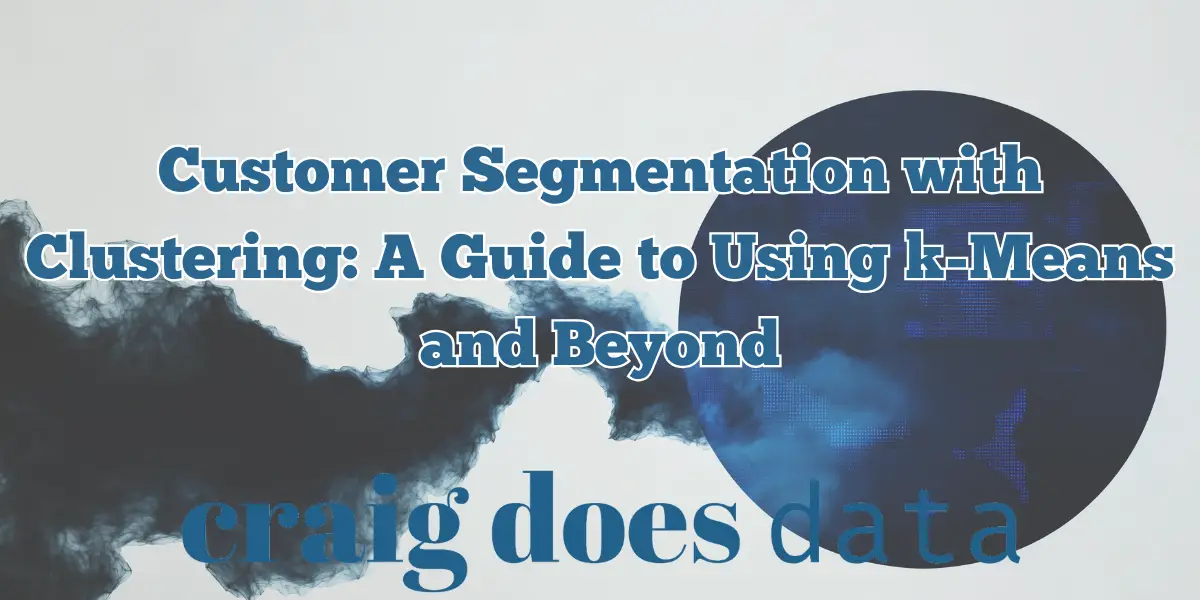
Customer Segmentation with Clustering: A Guide to Using k-Means and Beyond
Introduction
In today’s hyper-competitive business landscape, understanding your customers is no longer just a good idea—it’s a critical necessity. Companies big and small vie to create meaningful and personalized interactions, and the starting point is always knowing who your customers are. Customer segmentation, the practice of dividing a company's customer base into distinct groups, has emerged as a cornerstone of effective marketing and product strategy. Whether you're an e-commerce retailer tailoring promotions to specific audience segments or a subscription-based business fine-tuning services for different user tiers, segmentation empowers you to connect with customers more deeply and drive measurable growth.
In this comprehensive guide, we will explore how clustering—a powerful unsupervised learning technique—can revolutionize your customer segmentation strategy. Specifically, we will shine a spotlight on k-Means, one of the most widely used clustering algorithms, and then venture beyond its capabilities into more sophisticated approaches such as hierarchical clustering, DBSCAN, and Gaussian Mixture Models. By the end of this article, you will have a robust understanding of how to effectively segment your customers using clustering, interpret the results, and apply actionable insights to propel your business forward.
Clustering is crucial for customer segmentation because it allows you to discover natural groupings within your data, free from predefined labels or categories. The ability to let the data tell its own story is invaluable, especially in a time when businesses are overloaded with information but starved for meaningful insights. Whether you’re a seasoned data scientist or a business professional just dipping your toes into analytics, this guide aims to equip you with both a conceptual understanding and a practical toolkit to harness clustering methods effectively.
So, let’s dive in. We’ll begin by demystifying the concept of customer segmentation, explore the benefits of this practice, and look at how some leading companies are deploying these strategies to gain a competitive edge. From there, we’ll delve into the technical side of things, covering what clustering is, how it works, and why k-Means is often the first port of call for segmentation projects. Finally, we’ll venture beyond k-Means to examine more advanced clustering techniques, ensuring you have all the knowledge you need to pick the right method for your business challenges. Let’s get started on this journey to uncover your customers’ hidden patterns and elevate your data-driven decision-making.
What is Customer Segmentation?

Customer segmentation is the process of dividing a customer base into groups of individuals that share similar characteristics. These characteristics can include demographics (age, gender, location), behavior (purchase frequency, online browsing habits), or psychographics (lifestyle, interests, values). By effectively segmenting customers, businesses can tailor their products, marketing strategies, and customer service to better address the unique needs of each group.
Why does this matter? In an era where customers expect personalized experiences, generic marketing or one-size-fits-all strategies tend to fall flat. If you can segment your audience into smaller, more homogenous clusters, you can craft messages, offers, and products that resonate more deeply with each segment. This often leads to improved customer satisfaction, loyalty, and, ultimately, increased revenue. Segmentation also facilitates strategic resource allocation, as companies can invest in the most profitable or strategically important customer segments.
The benefits of customer segmentation are manifold:
- Personalized Marketing Campaigns: Targeted campaigns yield better engagement and conversion, enabling more effective use of marketing budgets.
- Improved Customer Satisfaction: Tailored experiences make customers feel valued, thereby increasing satisfaction and retention rates.
- Product Development Insights: Understanding the specific needs and preferences of different segments can guide product or service improvements.
- Resource Optimization: Companies can focus resources and energy on high-value segments, improving return on investment.
Real-world examples abound. Amazon, for instance, segments customers based on browsing and purchase history, personalizing product recommendations to drive sales. Netflix relies on robust segmentation to recommend content, leading to higher user satisfaction and reduced churn. Airlines segment customers into economy, business, and first-class travelers, adjusting not only price points but also the customer experience, loyalty programs, and more. These companies exemplify how segmentation can be a direct pathway to delivering superior customer experiences.
In essence, customer segmentation lets businesses “listen” more closely to what different groups within their customer base truly want. It’s about embracing the idea that not all customers are the same—and that acknowledging these differences can unlock untapped avenues for growth and innovation.
Clustering: The Backbone of Customer Segmentation

At its core, clustering is an unsupervised machine learning technique designed to group data points (in this case, customers) such that those in the same group are more similar to each other than to those in other groups. This similarity is typically quantified using distance metrics like Euclidean distance, Manhattan distance, or even more specialized domain-specific measures. The power of clustering in customer segmentation lies in its ability to reveal natural groupings in data without the need for labeled training sets.
There are several families of clustering algorithms, and each can be especially suited to different types of data and segmentation goals. Some of the major types include:
- Partitioning Methods: These methods, such as k-Means, aim to divide the data into a specified number of clusters. The algorithm iteratively adjusts the boundaries of each cluster to minimize some measure of variance within the clusters.
- Hierarchical Methods: Hierarchical clustering builds a tree (or dendrogram) of clusters. It can be agglomerative (starting with each data point as its own cluster and merging them) or divisive (starting with one large cluster and splitting it). This approach is useful for exploratory analysis and helps visualize relationships between different clusters.
- Density-Based Methods: Algorithms like DBSCAN define clusters as areas of high density separated by areas of low density. This allows for the discovery of arbitrarily shaped clusters and can handle outliers or “noise” points.
Clustering is especially valuable for customer segmentation because it automatically discovers subgroups that share certain patterns—whether they’re purchase behaviors, subscription durations, or usage frequencies. Unlike supervised learning approaches, which require pre-labeled data, clustering can deal with unlabeled data, making it ideal for exploratory segmentation where the goal is to reveal unknown patterns.
When you use clustering for segmentation, you effectively shift from a reactive stance (“We think these customer segments might exist”) to a proactive stance (“Let’s see what segments actually exist”). In a rapidly changing market, this approach can uncover emerging trends and behaviors faster, giving you a competitive edge.
In the next sections, we’ll dive deeper into how you can apply one of the most common clustering techniques—k-Means—to your customer data. We’ll also discuss when it makes sense to look beyond k-Means and explore more advanced algorithms like hierarchical clustering, DBSCAN, and Gaussian Mixture Models. By understanding the strengths and weaknesses of each, you can choose the method that aligns best with your data and business objectives.
Deep Dive into k-Means Clustering

When people talk about clustering for customer segmentation, they often start with k-Means—and for good reason. k-Means is relatively easy to implement, computationally efficient, and performs well under a wide range of conditions. It’s considered a partitioning algorithm because it partitions the dataset into a predefined number k of clusters.
The core idea is straightforward: k-Means aims to minimize the within-cluster sum of squares (WCSS), effectively grouping data points so that they’re as close to each other as possible in the feature space. Let’s break down how this works step by step.
Step-by-Step Guide to Implementing k-Means
Step 1: Data Preparation and Cleaning
Before you even think about applying k-Means, you need to ensure your data is in good shape. Data cleaning typically involves handling missing values, removing duplicates, and correcting any data entry errors. Feature engineering might also be necessary—deciding which variables (e.g., total spending, frequency of purchases, membership duration) will inform your clusters. The cleaner and more relevant your features, the better your clusters will be.
For example, if you work at a subscription-based company, you might want to focus on metrics like monthly usage frequency, churn risk score, average revenue per user, and the number of active sessions. By carefully selecting these variables, you are effectively shaping the feature space in which your algorithm will search for clusters.
Step 2: Choosing the Number of Clusters (k)
One of the trickiest aspects of k-Means is deciding how many clusters to look for. Typically, you can use methods like the elbow method or the silhouette score to guide your choice. In the elbow method, you plot the total within-cluster sum of squares against different k values and look for the “elbow” point where improvements start to level off. The silhouette score, on the other hand, measures how similar each data point is to its own cluster compared to other clusters. A high silhouette score suggests a well-defined cluster.
Remember that there is no one-size-fits-all approach here. You may need to balance interpretability with the algorithm’s statistical performance. A smaller number of clusters may be easier to interpret but could overlook finer nuances in customer behavior. Conversely, having too many clusters might complicate your marketing and operational strategies.
Step 3: Running the k-Means Algorithm
Once you’ve decided on k, you initiate the algorithm by randomly assigning each data point to one of the k clusters. Then the following steps occur iteratively:
- Centroid Calculation: For each cluster, calculate the centroid (the mean of all points in the cluster).
- Reassignment: Reassign each data point to the cluster whose centroid is closest, typically using Euclidean distance.
- Convergence Check: Repeat the steps until the assignments no longer change significantly or a predetermined number of iterations is reached.
Most data analysis libraries (such as scikit-learn in Python or MLlib in Apache Spark) offer built-in functions to run k-Means. By simply specifying k and plugging in your data, you can quickly cluster thousands—or even millions—of data points at scale.
Step 4: Analyzing and Interpreting the Results
After k-Means converges, you’ll have k clusters. The real work, however, is in interpreting these clusters. Look at the centroid of each cluster to see the “average” characteristics of its members. You might label a cluster of high-spending, low-frequency customers as “Luxury Occasional Shoppers” or a cluster of moderate-spending, high-frequency customers as “Enthusiastic Regulars.”
Visualizing the clusters can be immensely helpful. Dimensionality reduction techniques like PCA (Principal Component Analysis) can reduce your multi-dimensional data into two or three components, making it easier to plot and examine how your data points group together. Once you’ve labeled these clusters, you can tailor marketing strategies, product features, or customer support policies to each specific segment.
Pros and Cons of k-Means
Pros:
- Simple to understand and implement.
- Computationally efficient and can handle large datasets.
- Widely supported by various data analysis libraries.
Cons:
- Requires the user to specify the number of clusters k upfront.
- Assumes clusters are roughly spherical and of similar sizes.
- Sensitive to outliers and can converge to local minima.
Overall, k-Means is a powerful starting point for customer segmentation. It offers a balance between simplicity and performance and provides immediate insights into the structure of your data. However, as we’ll see, it’s not always the best tool for every job. In the next section, we’ll explore advanced clustering methods that can handle more complex scenarios.
Beyond k-Means: Advanced Clustering Techniques

While k-Means is a robust algorithm for many use cases, it does have limitations. It struggles with clusters that aren’t roughly spherical, and it’s quite sensitive to outliers. If your data contains irregularly shaped clusters, varying cluster densities, or a lot of noise, you may need a more flexible algorithm. In this section, we’ll look at some of the most common alternatives.
Limitations of k-Means
One of the biggest issues with k-Means is that it requires you to decide in advance how many clusters to form. In some scenarios, you might not know how many distinct groups are present in your data. Additionally, k-Means relies on centroid-based distance calculations and is best suited to data where clusters are roughly spherical in shape and have similar sizes. Extreme outliers can also pull centroids away from the “true” center of a cluster, reducing overall effectiveness.
Hierarchical Clustering
Hierarchical clustering builds a tree-like structure of nested clusters, known as a dendrogram. In agglomerative clustering, you start with each data point as its own cluster and merge them step by step. In divisive clustering, you start with one large cluster and split it repeatedly. The result is a hierarchy of clusters that can be visualized using the dendrogram. You can cut the dendrogram at different levels to obtain various numbers of clusters.
Hierarchical clustering is excellent for exploratory analysis because it doesn’t require you to specify the number of clusters upfront. You can examine the dendrogram to decide at which “height” to separate the data into clusters. However, hierarchical clustering can be computationally expensive for very large datasets, as each merge or split step needs to recalculate distances between clusters.
DBSCAN (Density-Based Spatial Clustering of Applications with Noise)
DBSCAN defines clusters as areas of high density separated by areas of low density. It requires two main parameters: eps (the radius of a neighborhood around a point) and min_samples (the minimum number of points required in that neighborhood to form a dense region).
The biggest advantage of DBSCAN is that it can find arbitrarily shaped clusters and handle outliers gracefully. Points that don’t belong to any high-density region are labeled as outliers (or “noise”). This makes it particularly useful in scenarios where you have non-uniform cluster densities or anomalous data points that you’d like to exclude from the main clusters.
However, DBSCAN can be tricky to tune: choosing the right eps and min_samples can be challenging and highly data-dependent. Also, DBSCAN might struggle if the data’s density varies significantly across different regions.
Gaussian Mixture Models (GMM)
Gaussian Mixture Models approach the clustering problem from a probabilistic standpoint, assuming that each cluster can be represented by a Gaussian distribution. Instead of assigning each data point to a single cluster definitively, GMM assigns probabilities of belonging to different clusters.
This probabilistic approach can be particularly useful in situations where the boundaries between clusters aren’t strict. For example, if you have customers who partially behave like “high-frequency, low-spend” but also show traits of “medium-frequency, medium-spend,” a GMM can capture this ambiguity better than k-Means.
GMM can also model clusters with different shapes and orientations. However, like k-Means, you still need to specify the number of components (clusters). Additionally, the algorithm is more computationally complex and might require careful initialization to converge to a suitable global optimum.
Choosing the Right Method
Selecting the best clustering algorithm depends on your data’s characteristics and your specific business goals. Here are some high-level guidelines:
- Data Shape and Distribution: If your data has irregular shapes or varies significantly in density, consider DBSCAN or hierarchical clustering.
- Interpretability: If you need interpretable clusters with clear centroids, k-Means is often simpler to communicate to stakeholders.
- Number of Clusters: If you’re unsure how many clusters to form, hierarchical clustering offers a more exploratory approach. GMM and k-Means both require you to specify the number of clusters upfront.
- Handling Outliers: DBSCAN naturally labels outliers, while k-Means is quite sensitive to them.
- Probabilistic Assignment: If a point’s membership could be split between multiple clusters, GMM’s probabilistic approach might provide richer insights.
By matching your data’s structure to an appropriate clustering method, you can generate more accurate and actionable customer segments. Understanding each algorithm’s strengths and limitations is vital for making an informed choice.
Practical Tips for Successful Customer Segmentation

Regardless of the clustering algorithm you choose, the success of your customer segmentation project depends on several best practices. Below are key tips that can significantly impact the quality and usability of your segmentation results.
Data Quality
High-quality data is the cornerstone of accurate segmentation. No algorithm can compensate for missing, incorrect, or irrelevant data. Start by ensuring that any data you include is both accurate and representative. This often involves working with multiple data sources—CRM systems, web analytics platforms, transaction logs—and reconciling any discrepancies. Dealing with missing data may mean either removing incomplete records or using imputation techniques, but be cautious that these choices can bias your results.
Feature Selection
Selecting the right variables (features) can make or break your segmentation. If you include too many variables, especially ones that don’t add meaningful information, you could introduce noise into your clusters. On the other hand, omitting key variables might cause the algorithm to overlook meaningful patterns. Feature selection methods such as correlation analysis, principal component analysis (PCA), or domain expertise can help you identify the most useful indicators of customer behavior.
As a practical example, if you run a subscription-based service, including “time since last login” alongside “subscription tier” and “average session length” can paint a richer picture of your customers than just looking at total usage.
Evaluating Cluster Results
After applying a clustering algorithm, it’s vital to assess whether the clusters formed are meaningful and actionable. Common metrics include:
- Silhouette Score: Measures how similar each data point is to others in its cluster compared to those in other clusters. Higher scores indicate better-defined clusters.
- Davies-Bouldin Index: Captures both within-cluster similarity and between-cluster separation. Lower values are better.
- Calinski-Harabasz Index: Also called the Variance Ratio Criterion, it evaluates the ratio of between-cluster dispersion to within-cluster dispersion.
But metrics alone aren’t enough. You also need to do a qualitative review. Do the clusters make sense from a business standpoint? Can you describe them in a way that resonates with marketing teams, product managers, or executives? Collaboration between data scientists and business stakeholders is essential to validate whether these clusters align with real-world customer behaviors.
Iterative Approach
Customer segmentation is rarely a one-and-done process. Markets evolve, consumer preferences shift, and new data becomes available. It’s important to adopt an iterative mindset. Periodically re-run your clustering algorithm with updated data, or refine your feature set to better capture emerging trends. By treating segmentation as a living, evolving project, you stay ahead of market changes and maintain more accurate insights about your customers.
Additionally, experimentation can be valuable. Try different clustering algorithms and features, then compare the results. This experimentation can uncover new angles to interpret your customer base, such as seasonal purchasing trends or changes in brand loyalty over time.
Conclusion
Customer segmentation stands at the heart of effective marketing, customer relationship management, and product development strategies. By dividing your audience into smaller, homogenous groups based on shared characteristics, you can deliver more personalized experiences, optimize resource allocation, and ultimately drive greater business value. Clustering algorithms like k-Means, hierarchical clustering, DBSCAN, and Gaussian Mixture Models each offer unique advantages and trade-offs, ensuring that you can find a method well-suited to your particular data and objectives.
In this article, we explored how to use clustering techniques for customer segmentation, providing a deep dive into k-Means while also touching upon more advanced methods. We also discussed practical considerations such as data quality, feature selection, and the importance of iterative analysis. The true power of clustering lies not just in identifying groups of customers but in translating those insights into actions—whether that’s designing a targeted marketing campaign, refining a product feature, or revamping customer support policies.
If you’re new to customer segmentation, start with a well-defined question: what do you hope to achieve by segmenting your customers? Then select an appropriate clustering method, keeping in mind the nature of your data and the metrics that will guide your decisions. Don’t be afraid to iterate—clustering is often as much an art as it is a science. With each iteration, you’ll refine your approach and uncover deeper insights into your customer base.
Above all, remember that segmentation is most powerful when it influences tangible business outcomes. Keep a clear line of communication open with key stakeholders to ensure that each new insight is immediately put to the test in marketing campaigns, feature rollouts, or customer service initiatives. This is how you turn data insights into real-world results.
So, take the plunge, experiment with clustering algorithms, and uncover the hidden structure in your customer data. Your efforts will not only lead to better decision-making and more efficient marketing spend but also to happier, more engaged customers—an outcome every company strives for.
FAQs
1. How do I know if my data is suitable for k-Means?
k-Means works best for data that is somewhat continuous and has clusters that are relatively compact and similar in size. If you suspect your data has elongated or irregular clusters, or if you have a lot of outliers, you might want to explore alternatives like DBSCAN or hierarchical clustering.
2. How often should I update my segmentation model?
This depends on how quickly your market and customer behaviors change. Some companies re-run their segmentation models every quarter, while others do it annually or whenever they introduce a major product or service update. The key is to keep an eye on performance metrics—if they start to slip, it might be time to refresh your segmentation.
3. What if my clusters overlap?
Overlapping clusters are common in many real-world scenarios. k-Means offers a hard assignment (each data point belongs to exactly one cluster). If you need more flexibility, consider Gaussian Mixture Models, which assign probabilities of belonging to each cluster.
4. Can I mix different clustering algorithms?
Yes, you can. Sometimes, a hybrid approach can yield interesting insights. For instance, you might use hierarchical clustering as an exploratory tool to determine the number of clusters and then apply k-Means or GMM to finalize the segmentation.
5. What if my business stakeholders find too many clusters confusing?
Always balance statistical validity with business pragmatism. Even if a model suggests eight clusters, you might consolidate them into four or five segments that are easier to act upon. The goal is not to create the “perfect” segmentation model in a vacuum, but rather to arrive at something that your marketing, sales, and product teams can realistically use.
6. How do I handle categorical variables in clustering?
k-Means is generally not ideal for purely categorical data, because it relies on Euclidean distance. However, you can encode categorical variables into numerical form (e.g., using one-hot encoding) or use algorithms designed for categorical data, such as k-modes or k-prototypes. Always review the suitability of distance metrics when dealing with mixed or categorical data.
References
Below is a list of resources that provide more information on clustering and customer segmentation, as well as some foundational texts on data science and machine learning:
- Tan, Steinbach, and Kumar, Introduction to Data Mining, Pearson, 2018.
- James, Witten, Hastie, and Tibshirani, An Introduction to Statistical Learning, Springer, 2021.
- “A Tutorial on Clustering Algorithms,” scikit-learn documentation: scikit-learn.org
- Han, Pei and Tong, Data Mining: Concepts and Techniques, Morgan Kaufmann, 2011.
- Sarstedt and Mooi, A Concise Guide to Market Research, Springer, 2019.
- Maimon, Rokach, Data Mining and Knowledge Discovery Handbook, Springer, 2010.
By exploring these materials, you can delve deeper into the theoretical underpinnings and practical applications of clustering in customer segmentation. Continuous learning and adaptation are vital in this fast-evolving field, ensuring that your segmentation strategies remain fresh, relevant, and effective over the long term.
What next?
If you found this article valuable and want to deepen your understanding of big data analytics, explore the additional resources available on our website. Share your own experiences, challenges, or questions with us via the contact page — we’d love to hear from you.
